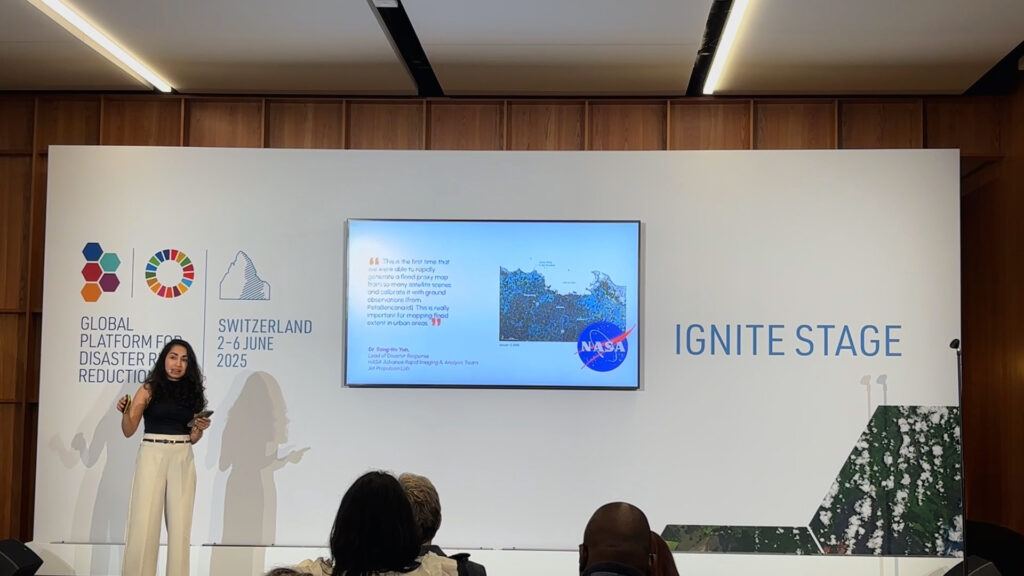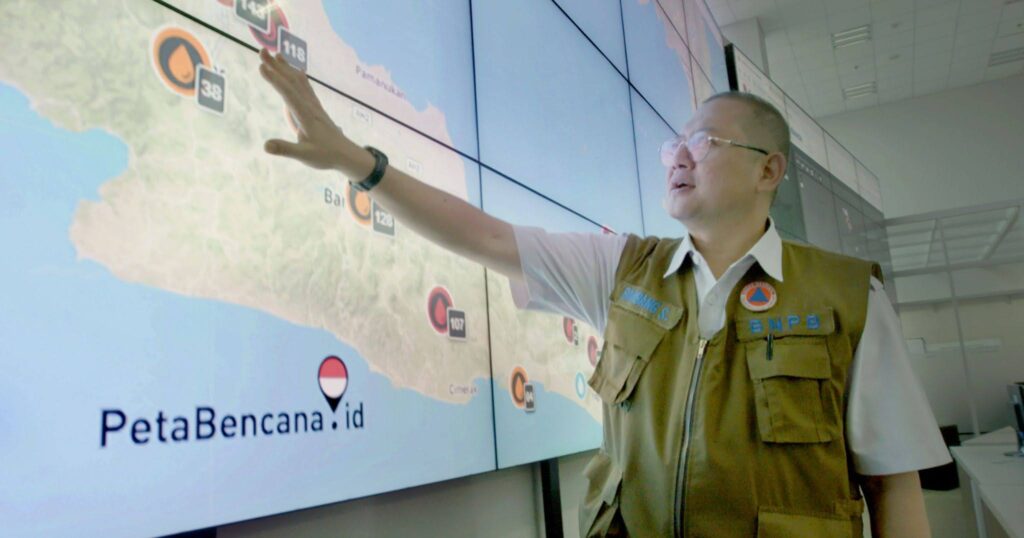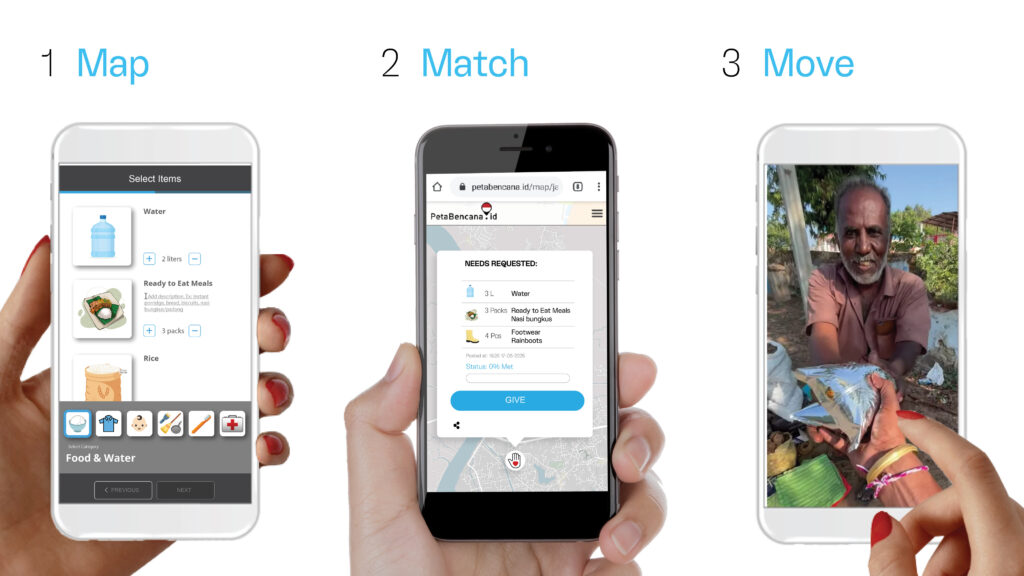At the recent UN climate negotiations in Bonn (SB62), talks have been marred by intense standoffs with little clarity on how the world will meet its adaptation goals. Recent discussions at the Intergovernmental Panel on Climate Change (IPCC) have failed to finalize the timeline for the Seventh Assessment Report (AR7), raising concerns about the availability of timely climate data for policy-making.
At a time when global climate science and action faces significant delays, local actors are stepping up to address the accelerating impacts of climate change. Today, we launched Peta Gotong Royong (Mutual Aid Map), a new AI-assisted platform designed to support peer-to-peer disaster relief, empower local action, and close critical gaps in humanitarian response. Built on the trusted foundation of PetaBencana.id — Peta Gotong Royong expands a decade-long commitment to strengthening community resilience through open, accessible technology.
“Communities must be equipped to act when disaster strikes,” said Nashin Mahtani, Director of Yayasan Peta Bencana. “Peta Gotong Royong builds upon the region’s strong traditions of mutual aid (“gotong royong”) by providing digital tools that match 21st-century challenges.”

Nashin Mahtani, Director of Disaster Map Foundation (Yayasan Peta Bencana) shared a preview of Peta Gotong Royong during the UN Global Platform for DRR in Geneva, where it received wide acclaim on the international stage.
Studies have shown that in the critical hours and days after a disaster, most life-saving actions and immediate aid come from those already on the ground. However, formal disaster response systems often struggle to integrate and support grassroots mutual aid effectively.
During disasters, social media platforms often become critical hubs for coordination and information sharing — but the sheer volume of posts can quickly become overwhelming, making it difficult to verify needs, prioritize responses, and ensure that aid reaches those who need it most. Peta Gotong Royong responds to these challenges by providing a free, open platform where anyone can report urgent needs, offer assistance, and be matched in real time — all using familiar tools like WhatsApp and mobile browsers. The platform is designed to harness the power of social media—where much of disaster response coordination already happens—and channel it into an organized, structured, actionable system that communities and volunteers can use.
“In times of crisis, it is communities that act as first responders. To build a more resilient Indonesia, we must continue to strengthen and harness the spirit of gotong royong (mutual aid), and one key way is through the use of PetaBencana.id. The risks we face can strike at any moment, and shared community-data through PetaBencana.id is both a vital contribution and a unique expression of gotong royong (mutual aid). The Mutual Aid Map (Peta Gotong Royong), as the latest initiative of PetaBencana.id, represents an important new form of collective action. Why is it called Gotong Royong (Mutual Aid)? Because it is leaderless, because we are all equal and we all work together to overcome the problems we face in our environments. The importance of this launch is to grow humanitarian support with Peta Gotong Royong by PetaBencana.id,” said Mr. Bambang Surya Putra, Director of Logistics and Equipment Management at the National Disaster Management Agency (BNPB) highlighting the importance of community participation in disaster response efforts.

Bambang Suryaputra, Director of Logistics and Equipment Management at the National Emergency Management Agency, highlights the importance of community participation via Peta Gotong Royong in disaster response efforts.
According to Indra Kurniawan, Head of the Disaster Management Department of Indonesian Red Cross Bogor 2015-2017 and also a Survivor of the Sukabumi Earthquake 2022,
“As a volunteer and community member who frequently responds directly to disaster sites, I truly understand the importance of fast and accurate information. Peta Gotong Royong by PetaBencana.id serves as a vital bridge—connecting residents, volunteers, communities, and the government—so we can recognize one another, support each other, and act together. It enables all stakeholders to easily identify unmet needs – whether it’s clean water, food, medicine – and respond more effectively. This is an important step forward in strengthening disaster response. I hope this tool continues to be socialized and used not only during disasters, but also in times of need. “
Already tested in early trial phases during the February 2025 floods, the platform demonstrated a 70% faster matching rate compared to conventional social media coordination alone.
“In March 2025, flash floods struck several areas in Padang Sidempuan, North Sumatra. Although I was far away in Deli Serdang, I coordinated with my colleagues from the Indonesian Red Cross (PMI) in Padang Sidempuan to submit a request for assistance through the Peta Gotong Royong feature on PetaBencana.id. A few days later, my request was answered by a donor, and the flood victims were able to receive much-needed basic supplies, such as sanitary products for women.
The Peta Gotong Royong feature is incredibly useful for communities. It allows us to request essential aid for disaster survivors quickly and effectively.
Indeed, PetaBencana.id is a powerful platform—not only for reporting disasters but also for facilitating mutual aid. We’re not just able to ask for help; we can also contribute and support others in need.”
Supriadi, Indonesian Red Cross (PMI) Deli Serdang, North Sumatra – Testimonial from a Peta Gotong Royong User
Zahrotul Ulya, Regional Executive Director of the Indonesian Family Planning Association in East Java underscored the importance of increasing community participation in disaster response and recovery. During the official launch event, she said
“Peta Gotong Royong by PetaBencana.id can invite more people to actively participate in providing assistance to those affected by disasters. With its easy access and transparent platform, communities feel more empowered to get involved and contribute meaningfully. The platform provides a tool to request a diverse set of needs including assistance for household needs, babies, children, and so on, providing a significant way to respond to specific needs during disasters.”
Echoing this statement, Al Razi Izzatul Yazid, Humanitarian Division Head of Rumah Zakat Indonesia emphasized the tool’s role in advancing locally-led humanitarian action, stating:
“The Mutual Aid Map (Peta Gotong Royong) by PetaBencana.id is a vital tool that helps identify urgent needs and empowers local communities, who are always the first responders in times of crisis. By supporting coordination and complementarity in humanitarian efforts, this platform embodies the core humanitarian commitment to effective, locally-led disaster response.”
I Nyoman Suartanu, from the Indonesian Hindu Dharma Council (PHDI), reflected on the cultural and spiritual resonance of the platform:
“Mutual aid is rooted in our humanity—it requires sincerity, volunteerism, and the willingness to rise above ego for the greater good. The latest initiative of PetaBencana.id, with Mutual Aid Map (Peta Gotong Royong), is not just a technological innovation; it is a moral call to unite across faiths and communities in the spirit of shared responsibility. At PHDI, our movement to love life aligns deeply with this initiative, and we are committed to strengthening disaster preparedness through collaboration, compassion, and collective action.”
The alignment with local wisdom was also praised by Yasser Atmanegara, Deputy Secretary of Muhammadiyah Disaster Management Center Jakarta, who stated:
“First of all I was very happy that this name was chosen appropriately because this is a technological breakthrough grounded in local wisdom, the spirit of gotong royong. Mutual Aid Map holds great promise as a platform for not only coordination, but collaboration, across organizations, enabling faster, more effective, and more direct aid distribution. It helps cut bureaucracy, supports peer-to-peer response, and becomes a vital record of public participation in disaster response and recovery. This shows how strong our society truly is when we work together.”
As Southeast Asia faces increasing climate risks, initiatives like Peta Gotong Royong demonstrate the potential of AI in enhancing disaster resilience and response. While global climate science navigates political challenges, local communities are taking proactive steps to safeguard their futures.
The platform also reflects broader trends toward decentralized disaster governance, as recognized in recent ASEAN frameworks on climate resilience. As global political delays threaten to slow global climate science and coordinated international response, innovations like Peta Gotong Royong offer a path forward — one where communities are not waiting for help, but leading the way.

Key Features of Peta Gotong Royong:
- Real-Time Needs Reporting: Affected individuals can report their needs through the platform, allowing anyone to respond with precise and timely assistance.
- Decentralized Matching System: Community members, local organizations, and volunteers can coordinate directly, reducing delays in aid distribution.
- Open Data for Transparency: The platform maintains publicly accessible records of aid requests and fulfillment to enhance accountability and avoid duplication.
- Seamless Integration with Social Media: Designed to work with popular messaging apps, making participation easy and accessible for a broad audience.
Leave a Reply